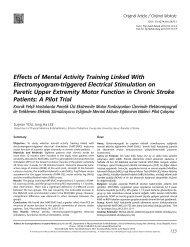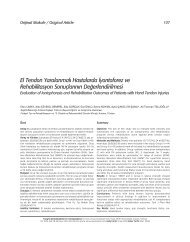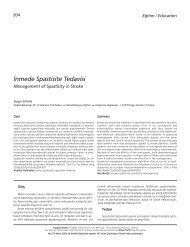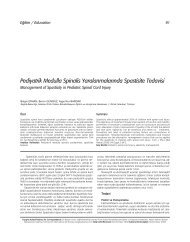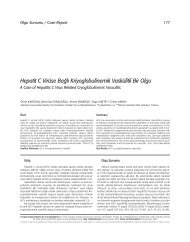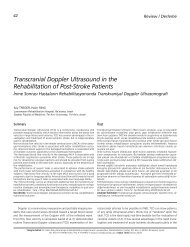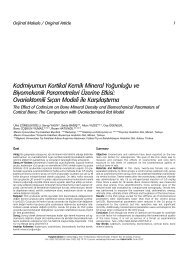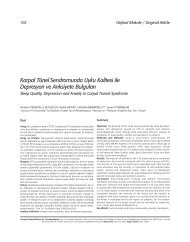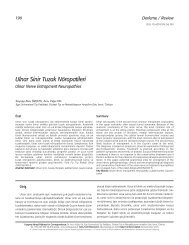FTR 2009-1 KAPAK - Türkiye Fiziksel Tıp ve Rehabilitasyon Dergisi
FTR 2009-1 KAPAK - Türkiye Fiziksel Tıp ve Rehabilitasyon Dergisi
FTR 2009-1 KAPAK - Türkiye Fiziksel Tıp ve Rehabilitasyon Dergisi
You also want an ePaper? Increase the reach of your titles
YUMPU automatically turns print PDFs into web optimized ePapers that Google loves.
Original Article / Orijinal Makale<br />
Early Rehabilitation Outcome and Demographic and<br />
Clinical Features of Patients with Traumatic Tendon Injury<br />
Travmatik Tendon Yaralanmal› Hastalar›n Erken <strong>Rehabilitasyon</strong><br />
Sonuçlar› <strong>ve</strong> Demografik, Klinik Özellikleri<br />
Bengi ÖZ, Serpil BAL, Cenk DEM‹RDÖVEN*, Asuman MEM‹fi, Alev GÜRGAN*, Bar›fl fiAH‹N*, Hasan Yücel ÖZTAN*<br />
Atatürk E¤itim <strong>ve</strong> Araflt›rma Hastanesi, Fizik Tedavi Klini¤i <strong>ve</strong> *Plastik <strong>ve</strong> Rekonstrüktif Cerrahi Klini¤i, ‹zmir, Turkey<br />
Summary<br />
Objecti<strong>ve</strong>: Tendon injuries are among the most common forms of<br />
traumatic hand injuries. We aimed in this study to report the rehabilitation<br />
outcomes of flexor, extensor and combined tendon injuries.<br />
Materials and Methods: Thirty-se<strong>ve</strong>n patients (110 digits) with traumatic<br />
hand injury who were treated by plastic and reconstructi<strong>ve</strong> surgery and<br />
attended our outpatient clinic for rehabilitation were included in the study.<br />
Twenty-fi<strong>ve</strong> patients (67.6 %) with 78 tendons had flexor (FTI), 8 patients<br />
(21.6%) with 18 tendons had extensor (ETI), and 4 patients (10.8%) with 12<br />
tendons had both flexor and extensor tendon injury (combined) (CTI).<br />
Patients with FTI were treated by the Kleinert protocol, and those with ETI<br />
and CTI were treated by the immobilization technique. Patients in all groups<br />
were assessed by the total acti<strong>ve</strong> motion (TAM) scoring system of the<br />
American Society of Surgery of Hand (ASSH), distal palmar crease-finger tip<br />
distance (DPCFD), and wrist range of motion (ROM) at the 4th and 8th<br />
weeks of the rehabilitation protocol.<br />
Results: Excellent and good results were obtained in 51.3% of FTI<br />
patients, 94.4% of ETI patients and 58.4% of CTI patients.<br />
Conclusion: E<strong>ve</strong>n at the 8th week of the rehabilitation period ETI results of<br />
our patients were satisfactory. Both FTI and CTI patients had fewer<br />
excellent and good results at the 8th week and these injuries need close and<br />
longer follow up of the patients. Turk J Phys Med Rehab <strong>2009</strong>;55:19-24.<br />
Key Words: Rehabilitation outcome, traumatic tendon injury<br />
Introduction<br />
Restoring digital function after flexor tendon injuries continues<br />
to be one of the great challenges in hand surgery. Despite<br />
enhanced results after tendon repair, problems of stiffness,<br />
scarring, and functional impairment persist in hand surgery (1).<br />
Özet<br />
19<br />
Amaç: Travmatik el yaralanmalar›n›n en s›k görülen flekillerinden biri tendon<br />
yaralanmalar›d›r. Bu çal›flmada fleksör, ekstensör <strong>ve</strong> kombine tendon<br />
yaralanmalar›n›n rehabilitasyon sonuçlar›n› yay›nlamay› amaçlad›k.<br />
Gereç <strong>ve</strong> Yöntem: Plastik <strong>ve</strong> Rekonstriktif Cerrahi klini¤imizde opere olmufl<br />
<strong>ve</strong> poliklini¤imize rehabilitasyon amaçl› baflvurmufl 37 travmatik el<br />
yaralanmal› hasta (110 parmak) çal›flmaya al›nd›. Yetmiflsekiz tendon ile<br />
25 hastan›n (%67,6) fleksör (FTY); 18 tendon ile 8 hastan›n (%21,6) ekstensör<br />
(ETY) <strong>ve</strong> 12 tendon ile 4 hastan›n (%10,8) hem fleksör hem de<br />
ekstensör tendon yaralanmas› (kombine) (KTY) mevcuttu. FTY olan hastalar<br />
Kleinert protokolü ile; ETY <strong>ve</strong> KTY olan hastalar immobilizasyon<br />
tekni¤i ile tedavi edildi. Tüm gruplardaki hastalar, Amerikan El Cerrahisi<br />
Birli¤ine ait total aktif hareket skorlama sistemine, distal palmar çizgi<br />
parmak ucu mesafesine <strong>ve</strong> el bile¤i eklem hareket aç›kl›¤›na göre rehabilitasyon<br />
protokolünün 4. <strong>ve</strong> 8. haftalar›nda de¤erlendirildi.<br />
Bulgular: FTY hastalar›n %51,3’ünde, ETY hastalar›n %94,4’ünde <strong>ve</strong><br />
KTY hastalar›n %58,4’ünde iyi <strong>ve</strong> mükemmel sonuçlar sa¤land›.<br />
Sonuç: ETY hastalar›n rehabilitasyon sonuçlar› rehabilitasyonun 8. haftas›nda<br />
bile tatmin ediciydi. Hem FTY’l› hastalar hem de KTY hastalarda<br />
8. haftada daha düflük iyi <strong>ve</strong> mükemmel sonuçlar elde edilmifltir <strong>ve</strong> bu<br />
yaralanmalar daha uzun <strong>ve</strong> daha yak›ndan izlem gerektirir. Türk Fiz T›p<br />
Rehab Derg <strong>2009</strong>;55:19-24.<br />
Anahtar Kelimeler: <strong>Rehabilitasyon</strong> sonuçlar›, travmatik tendon yaralanmalar›<br />
The effect of an injury on the extensor tendons is often regarded<br />
less seriously than a flexor tendon injury. The treatment and<br />
rehabilitation of the injury are often belie<strong>ve</strong>d to be less timeconsuming,<br />
and associated with a relati<strong>ve</strong>ly favourable prognosis<br />
compared with flexor tendon injuries. Howe<strong>ve</strong>r, experience<br />
demonstrates that injuries to the extensor tendons can be equally<br />
complex, time consuming, frustrating and disappointing (2).<br />
Address for Correspondence/Yaz›flma Adresi: Dr. Bengi Öz, Il›ca mah. Eyüp cad. Bahar Apt. 26/9 Narl›dere, ‹zmir, Turkey<br />
Phone: +90 232 244 44 44/2738 E-mail: bengiates@yahoo.com.tr Recei<strong>ve</strong>d:/Gelifl Tarihi January/Ocak 2008 Accepted/Kabul Tarihi: August/A¤ustos 2008<br />
© Turkish Journal of Physical Medicine and Rehabilitation, Published by Galenos Publishing. All rights reser<strong>ve</strong>d. / © <strong>Türkiye</strong> <strong>Fiziksel</strong> T›p <strong>ve</strong> <strong>Rehabilitasyon</strong> <strong>Dergisi</strong>, Galenos Yay›nc›l›k taraf›ndan bas›lm›flt›r. Her hakk› sakl›d›r.
20<br />
Öz et al.<br />
Early Rehabilitation Outcome of Tendon Injury<br />
The purpose of this study was to evaluate the results of<br />
flexor and extensor tendon injuries together with complex tendon<br />
injuries where both of them were affected and to in<strong>ve</strong>stigate the<br />
factors influencing the outcome.<br />
Materials and Methods<br />
A hundred-ten patients attended the rehabilitation clinic after<br />
surgical treatment in the Reconstructi<strong>ve</strong> Surgery Department for<br />
traumatic tendon rupture of the hand. Of 110 patients, only 37<br />
participated in the study, and the others failed to attend follow up<br />
visits. Twenty-fi<strong>ve</strong> patients with 78 tendons had flexor (FTI); 8<br />
patients with 18 tendons had extensor (ETI), and 4 patients with<br />
12 tendons had both flexor and extensor tendon injury<br />
(combined) (CTI) in all zones of the hand.<br />
Patients with fracture, finger implantation, burn injury and<br />
other non-traumatic tendon ruptures, and those with postoperati<strong>ve</strong><br />
periods of more than 30 days were excluded from the<br />
study. Age, gender, occupation, dominant hand, affected hand,<br />
cause of trauma, number of affected fingers, associated ner<strong>ve</strong><br />
and vascular injury and zone of injury were recorded.<br />
Surgery Technique<br />
All patients had been operated on in plastic and reconstructi<strong>ve</strong><br />
surgery department at our hospital. Tendons were repaired by<br />
use of the modified Kessler technique with 4-0 prolene sutures.<br />
Postoperati<strong>ve</strong> Management<br />
The modified Kleinert protocol was used to treat the patients<br />
with FTI. In the early stage (0-3 weeks), a modified Kleinert splint<br />
was used and passi<strong>ve</strong> flexion and acti<strong>ve</strong> extension exercises were<br />
performed 10 times by the patients e<strong>ve</strong>ry hour at home. In the<br />
intermediate stage (3-6 weeks), the splint was discontinued<br />
depending on the quality of tendon glide and the wrist<br />
immobilized in the neutral position between exercise sessions.<br />
Isolated tendon gliding and tenodesis wrist exercises were<br />
initiated. In the late stage (6-8 weeks), resisted and blocking<br />
exercises were began.<br />
The immobilization technique was used to treat the patients<br />
with ETI. During the first 3 postoperati<strong>ve</strong> weeks, injured hands<br />
were immobilized by splinting the wrist in 40-45 0 extension,<br />
metacarpophalangeal (MP) joint 0-20 0 flexion and IP joints in<br />
the neutral position. During this period, patients were seen<br />
weekly keeping the other joints in the extension position; passi<strong>ve</strong><br />
proximal (PIP) and distal interphalangeal (DIP) range of<br />
motion (ROM) exercises and metacarpophalangeal (MP) flexion<br />
(less than 40 0 ) exercises were performed by the same<br />
therapist. In the intermediate stage (3-6 th weeks), home<br />
exercises including combined flexion with wrist extension, isolated<br />
finger extension, intrinsic plus position and claw hand<br />
position exercises were started. In the late stages (6-8 th weeks),<br />
combined flexion with wrist flexion and resisti<strong>ve</strong> exercises were<br />
performed. All home exercises were prescribed 10 times e<strong>ve</strong>ry<br />
hour.<br />
The immobilization protocol was preferred for the rehabilitation<br />
of patients with CTI as the exercises were performed more<br />
protecti<strong>ve</strong>ly.<br />
Assessment<br />
All patients were assessed by the same author at the 4 th<br />
and 8th weeks. Flexion and extension of each joint were<br />
measured using a manual goniometry and the flexion<br />
and extension deficits were recorded. Outcome was<br />
analyzed using the total acti<strong>ve</strong> motion (TAM) scoring system of<br />
The American Society of Surgery of Hand (ASSH). TAM was<br />
defined as the sum of the DIP, PIP and MP flexion minus the<br />
sum of the DIP, PIP, and MP extension deficits. For each finger<br />
(2-5) TAM is divided by 260 0 expressed as a percentage.<br />
The ASSH rating of the results was, excellent 100%, good 75 to<br />
99%, fair 50 to 74% and poor below 50% (3). Wrist ROM in<br />
e<strong>ve</strong>ry direction and distal palmar crease- finger tip distance<br />
(DPCFD) of all the patients were also measured at the 4 th and<br />
8 th weeks. Early participating in the rehabilitation protocol<br />
(first week postoperati<strong>ve</strong>ly or not) and starting time of<br />
acti<strong>ve</strong> motion of tendons after the early phase of rehabilitation<br />
protocol (3-4 th week or 5-6th week) were recorded in all<br />
groups.<br />
Statistical Analysis<br />
The mean TAM measurements, DPCFD and wrist ROM<br />
measurements of the 4 th and 8 th week were compared using<br />
the Wilcoxon ranked test with significance set at p
Turk J Phys Med Rehab <strong>2009</strong>;55:19-24<br />
Türk Fiz T›p Rehab Derg <strong>2009</strong>;55:19-24<br />
week visit values in all groups (p
22<br />
Öz et al.<br />
Early Rehabilitation Outcome of Tendon Injury<br />
Table 3. Distal palmar crease-finger tip distance, wrist range of motion, and total acti<strong>ve</strong> motion results of the all groups.<br />
4 th week 8 th week<br />
Turk J Phys Med Rehab <strong>2009</strong>;55:19-24<br />
Türk Fiz T›p Rehab Derg <strong>2009</strong>;55:19-24<br />
Mean±SD Mean±SD p value<br />
(Min/Max) (Min/Max)<br />
DPCFD (cm) 3.1±1.7 1.9±1.9
Turk J Phys Med Rehab <strong>2009</strong>;55:19-24<br />
Türk Fiz T›p Rehab Derg <strong>2009</strong>;55:19-24<br />
Most of our FTI were zone V injuries. In contrast to ETI, FTI<br />
were mostly accompanied with major ner<strong>ve</strong> (median and ulnar)<br />
and artery (radial and ulnar) injuries in zone V. This type of<br />
injury is called as “spaghetti wrist, suicide wrist or full house<br />
syndrome” by various authors (5,6). Chin et al. (7) reported<br />
results of 60 patients with spaghetti wrist and obtained good to<br />
excellent results in only 19 of patients. In another study with a<br />
fewer number of patients, at the end of the rehabilitation only<br />
half of the fingers had a full acti<strong>ve</strong> ROM while the others had<br />
significant fixed deformities (8). Hudson et al. (5) studied 15<br />
patients with both median and ulnar ner<strong>ve</strong> injury associated<br />
with zone V FTI and 54% of them had good and excellent<br />
results and 20% had poor results. In these studies poor results<br />
were attributed to inadequate compliance of the patients with<br />
the post-operati<strong>ve</strong> therapy programs. If patients with associated<br />
injuries were excluded, the outcome yielded better results in<br />
FTI. Thus, Çetin A et al. (9) found 73% excellent results according<br />
to Buck Gramcko classification. Hunk LK (10) achie<strong>ve</strong>d 77%<br />
excellent-good results in zones other than zone II, if<br />
the associated injury was only digital ner<strong>ve</strong> in an acti<strong>ve</strong><br />
mobilization program.<br />
Although not all of our patients with FTI had the spaghetti<br />
wrist, most of them had accompanying ner<strong>ve</strong> injury. Our FTI<br />
patients had ner<strong>ve</strong> or vascular injuries with a ratio of 22/25 and<br />
10/25 respecti<strong>ve</strong>ly. Excellent and good results were obtained in<br />
only 50.3% of FTI patients. Poor compliance of the FTI patients<br />
with the rehabilitation program was obser<strong>ve</strong>d during the<br />
follow-up period. In some patients starting acti<strong>ve</strong> motion was<br />
delayed up to six weeks in our study. The patients started the<br />
acti<strong>ve</strong> motion at the 3 rd -4 th weeks had higher TAM values than at<br />
5 th -6 th weeks in FTI, but this was not statistically significant. Also<br />
follow-up period of the patients were shorter than most of the<br />
previous studies. Edinburg M (11) the modified Kleinert technique<br />
for flexor tendon divisions with associated injuries and had goodexcellent<br />
results of 61% in 70 digits at the end of<br />
follow up period ranged from 2 to 8 months. All these factors<br />
might contribute to the poor outcome of patients with FTI in TAM<br />
values.<br />
The patients with FTI also had lower wrist ROM compared to<br />
the other groups. Too much wrist flexion can make it difficult to<br />
regain extension with an injury so close to the wrist and to the<br />
flexor retinaculum, a prime source for flexor adhesions, and the<br />
authors recommended protection oft the patient, with the wrist<br />
as close to a neutral position as possible (3). It is interesting to<br />
find higher wrist ROM in CTI patients who had immobilized wrist<br />
at the neutral position at the 4 th week visit.<br />
Excellent and good results were obtained in 94.4% of ETI<br />
patients in our study. We performed tenodesis exercises<br />
weekly at follow up visits of the mobilization period, <strong>ve</strong>ry early<br />
in the rehabilitation period. Synergistic wrist and finger motion,<br />
which provides for finger flexion with wrist extension and finger<br />
extension with wrist flexion, is considered to be a good<br />
postoperati<strong>ve</strong> therapy after tendon repair because force<br />
is relati<strong>ve</strong>ly low and excursion is relati<strong>ve</strong>ly high (12). Tenodesis<br />
exercises might result in less adhesions and better TAM values.<br />
Russell RC found that ETI patients regained 80% or more of<br />
their hand function when assessed at 10 weeks in both static<br />
and dynamic splint groups (13). Bulstrode NW et al. reported<br />
good or excellent results in all of the patients with ETI<br />
randomized to three different rehabilitation regimes at the 12 th<br />
week (4). Research on extensor lacerations has yielded a wide<br />
spectrum of results; excellent to good results ranged between<br />
64%-to-%92 in other studies (14-16). The ratios that were<br />
reported might be affected by the zone of the injury in ETI;<br />
immobilized distal ETI ha<strong>ve</strong> serious gliding problems resulting<br />
in 50% loss of finger motion (17). Most of our ETI patients were<br />
in zones 4 and abo<strong>ve</strong>. This might explain the higher excellent to<br />
good ratio in ETI.<br />
In the literature, complex tendon injury (both flexor and<br />
extensor injury) was not studied sufficiently compared with other<br />
injuries. Newport et al. reported complex extensor tendon injury,<br />
but fracture, dislocation, joint capsule injury together with flexor<br />
tendon injury achie<strong>ve</strong>d only 45% good to excellent results (14).<br />
Conclusion<br />
E<strong>ve</strong>n at the 8 th week of the rehabilitation period, the ETI<br />
results of our patients were satisfactory. Both FTI and CTI<br />
patients had lower excellent and good results at the 8 th week and<br />
these injuries need close and longer follow up of the patients.<br />
Having simultaneous ner<strong>ve</strong> and/or combined tendon injury,<br />
beginning tenodesis exercises late, too much wrist flexion, and<br />
structural differences were considered to affect the rehabilitation<br />
results of FTI.<br />
References<br />
Öz et al.<br />
Early Rehabilitation Outcome of Tendon Injury<br />
Table 4. Functional results according to the scoring system of American Society of Surgery of Hand (ASSH) in all groups.<br />
Excellent Good Fair Poor<br />
Flexor tendon injury n (%) 8 (10.3) 32 (41) 16 (20.5) 22 (28.2)<br />
Extensor tendon injury n (%) 4 (22.2) 13 (72.2) 0 (0) 1 (5.6)<br />
Combined tendon injury n (%) 2 (16.7) 5 (41.7) 2 (16.7) 3 (25)<br />
23<br />
1. Culp RW, Taras SJ. Primary care of flexor tendon injuries.<br />
In:Hunter JM, Mackin EJ, Callahan AD (editor). Rehabilitation of<br />
the hand and upper extremity. 5th edition Volume 1 Mosby,<br />
Missouri 2002. p.415-30.<br />
2. Rosenthal EA. The extensor tendons:anatomy and management.<br />
In:Hunter JM, Mackin EJ, Callahan AD (editor). Rehabilitation of<br />
the Hand and Upper Extremity. 5th edition Volume 1 Mosby,<br />
Missouri 2002. p.498-541.<br />
3. Pettengill KMS, Van Strien G. Postoperati<strong>ve</strong> management of<br />
flexor tendon injuries. In: Mackin EJ (editor) Rehabilitation of the<br />
hand and upper extremity 5th edition Volume 1 Mosby, Missouri<br />
2002. p.431-57.<br />
4. Bulstrode NW, Burr N, Pratt AL, Grobbelaar AO. Extensor tendon<br />
rehabilitation a prospecti<strong>ve</strong> trial comparing three rehabilitation<br />
regimes. J Hand Surg 2005;30B:2:175-9.
24<br />
Öz et al.<br />
Early Rehabilitation Outcome of Tendon Injury<br />
5. Hudson DA, de Jager LT. The Spaghetti wrist: simultaneous<br />
laceration of the median and ulnar ner<strong>ve</strong>s with flexor tendons at<br />
the wrist. J Hand Surg Br 1993;18:171-3.<br />
6. Yii NW, Urban, Elliot D. A prospecti<strong>ve</strong> study of flexor tendon<br />
repair in zone 5. J Hand Surg 1998;23B:642.<br />
7. Chin G, Weinzweig N, Mead M, Gonzalez M. ‘Spaghetti wrist’:<br />
management and results. Plast Reconstr Surg 1998;102:96-102.<br />
8. Rogers GD, Henshall AL, Sach RP, Wallis KA. Simultaneous<br />
laceration of the median and ulnar ner<strong>ve</strong>s with flexor tendons at<br />
the wrist. J Hand Surg Am 1990;15:990-5.<br />
9. Çetin A, Dinçer F, Keçik A, Çetin M: Rehabilitation of flexor<br />
tendon injuries by use of a combined regimen of modified<br />
Kleinert and modified Duran technique. Am J Phys Med Rehabil<br />
2001;80:721-8.<br />
10. Hung LK, Yeung PLC, Wong JMW: Acti<strong>ve</strong> mobilization after<br />
tendon repair: comparison of results following injuries in zone 2<br />
and other zones. J Orthop Surg 2005:13:158-63.<br />
Turk J Phys Med Rehab <strong>2009</strong>;55:19-24<br />
Türk Fiz T›p Rehab Derg <strong>2009</strong>;55:19-24<br />
11. Edinburg M, Widgerow AD, Biddulph SL. Early postoperati<strong>ve</strong><br />
mobilization of flexor tendon injuries using a modification of the<br />
Kleinert technique. J Hand Surg Am 1987;12:34-8.<br />
12. Lieber R, Silva M, Amiel D Gelberman RH. Wrist and digital joint<br />
motion produce unique flexor tendon force and excursion in the<br />
canine forelimb. J Biomech 1999;32:175-81.<br />
13. Russell RC. Jones M, Grobbelaar A. Extensor tendon repair:<br />
mobilize or splint? Chirurgie de la main 2003;22:19-23.<br />
14. Newport ML, Blair WF, Steyers CM Jr. Long-term results of<br />
extensor tendon repair. J Hand Surg 1990;15A:961-6.<br />
15. Rolph-Roeming K. Early mobilization of extensor tendon<br />
lacerations in zones III and IV. J Hand Ther 1992;5:45.<br />
16. Crosby CA, Wehbe MA, Mawr B. Early protected motion after<br />
extensor tendon repair. J Hand Surg 1999;24A:1061-70.<br />
17. Lowett WL, Mc Calla MA. Management and rehabilitation of<br />
extensor tendon injuries. Orthop Clin North Am 1983;14:152-3.



